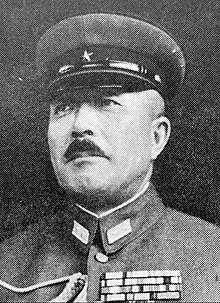Itagaki Seishirō
Itagaki Seishirō ( Japanese 板垣 征 四郎 ; born January 21, 1885 in Morioka , Japan , † December 23, 1948 in Tokyo ) was a general of the Imperial Japanese Army and Japanese Minister of the Army . Alongside Ishiwara Kanji, he is considered to be the main person responsible for the so-called Mukden incident .
Life
Itagaki Seishirō was born in Morioka in 1885 into a samurai family. In 1904 he graduated from the Imperial Japanese Army Academy and subsequently took part in the Russo-Japanese War .
From 1924 to 1926 he served as a military attaché in China and after his return held various staff posts in the Imperial Japanese Army General Staff before he took over command of the 33rd Infantry Brigade stationed in China in 1927. From 1928 to 1929 he commanded the 33rd Infantry Regiment, which was also stationed in China and was part of the Guandong Army .
During this time he came into increasing contact with the Japanese military intelligence service Kempeitai and in 1931 finally became department head of the Keimpeitai department affiliated with the Guandong Army. In this function he supported the secret planning which led to the Mukden incident and thereby to the occupation of Manchuria and the establishment of the Japanese puppet state of Manchukuo . From 1932 to 1934 he then served as a military advisor to the newly formed Manchurian Army .
In 1934 Itagaki was first deputy chief of staff of the Kwantung Army before he was appointed acting chief of staff in 1936.
From 1937 to 1938 he commanded the 5th Division in the early phase of the Second Sino-Japanese War and took part in the Battle of Peking-Tianjin and the Battle of Taiyuan , among others . During the battle of Tai'erzhuang , the division suffered a major defeat for the first time.
In 1938 he was recalled to Japan to serve as Minister of the Army for a short time. In this function he took part in the Five Ministerial Conference on December 6, 1938 , which passed the resolution to forbid Jews who had fled the German Reich from settling in Manchukuo and Japan.
In 1939 he returned to China and took over the post of Chief of Staff of the China Expeditionary Army there until 1941 . He was then made commander of the Chosen Army and retained this post when it was converted into the 17th Regional Army in April 1945 . On September 12, 1945, in Singapore , he signed the surrender of all remaining Japanese troops in Southeast Asia.
After the war he was arrested by the Allied occupation authorities and charged with various war crimes, particularly in connection with the occupation of Manchuria and the further escalation of the war in China during his time as Minister of the Army. In 1948 a military tribunal found him guilty on most counts and sentenced to death . He was hanged in Sugamo Prison in Tokyo on December 23, 1948 .
swell
literature
- Richard Fuller: Shokan: Hirohito's Samurai. Arms and Armor, London 1992, ISBN 1-854-09151-4 .
- Timothy P. Maga: Judgment at Tokyo: The Japanese War Crime Trials. University Press of Kentucky, 2001, ISBN 0-813-12177-9 .
Web links
- Itagaki Seishirō in the database of generals of World War II . Retrieved December 29, 2010.
- Itagaki Seishirō in the Encyclopedia of the Pacific War . Retrieved December 29, 2010.
Individual evidence
- ^ Budge, Encyclopedia of the Pacific War
- ↑ Ammenthorp, database of the generals of World War II
- ↑ Fuller, Shokan, Hirohito's Samurai
- ↑ Kazutomo Wakase: 続 ・ 日本人 が 知 っ て は な ら な い 歴 史 . 朱 鳥 社, 2007, ISBN 4434113585 , p. 41.
- ↑ Question戦前の日本における対ユダヤ人政策の基本をなしたと言われる「ユダヤ人対策要綱」に関する史料はありますか.また,同要綱に関する説明文はありますか. . Japanese Ministry of Foreign Affairs. Retrieved October 6, 2010.
- ↑ 猶太人 対 策 要 綱 . In: Five ministers council . National Archives of Japan. December 6, 1938. Archived from the original on July 26, 2011. Info: The archive link was automatically inserted and not yet checked. Please check the original and archive link according to the instructions and then remove this notice. Retrieved October 6, 2010.
- ^ Maga, Judgment at Tokyo
| personal data | |
|---|---|
| SURNAME | Itagaki, Seishirō |
| ALTERNATIVE NAMES | 板垣 征 四郎 (Japanese) |
| BRIEF DESCRIPTION | General of the Imperial Japanese Army |
| DATE OF BIRTH | January 21, 1885 |
| PLACE OF BIRTH | Morioka , Japanese Empire |
| DATE OF DEATH | December 23, 1948 |
| Place of death | Tokyo , Japanese Empire |
